Note: This website was automatically translated, so some terms or nuances may not be completely accurate.
Who should solve the "bone marrow donor shortage"? Society? Businesses? Government? ~ "#Connect Project Orange" Launches September 16 ~
When you hear about the "shortage of bone marrow donors," can you relate it to yourself? Honestly, most people probably feel it's something distant from their own lives. I myself have a bitter experience: I learned that a child in a family I knew needed a bone marrow transplant, so I impulsively registered as a donor, only to find out soon after that I was no longer within the eligible age range. While an increase in donor registrations is certainly a positive thing, I believe this is also a crucial moment for more individuals and companies to raise awareness and drive societal change.
The Japan Marrow Donor Program (JMDP), a public interest incorporated foundation connecting patients awaiting bone marrow transplants with donors, launched the new "#Connect Project Orange" campaign (https://www.jmdp.or.jp/tsunage-projectorange/) on the occasion of World Marrow Donor Day (WMDD) on Saturday, September 16, 2023. hereafter WMDD). This campaign aims to raise awareness about various challenges, including the "shortage of bone marrow donors," and to connect the "network of bonds" among all those who wish to support the cause. It is planned to continue over multiple years.
A kickoff event was held on the same day, featuring presentations by the Japan Marrow Donor Program (JMDP), companies, and media organizations tackling this issue. They discussed what each can and should do. This article examines the core challenges facing the Marrow Donor Program and explores how companies and media can participate in solving them, based on the event report.
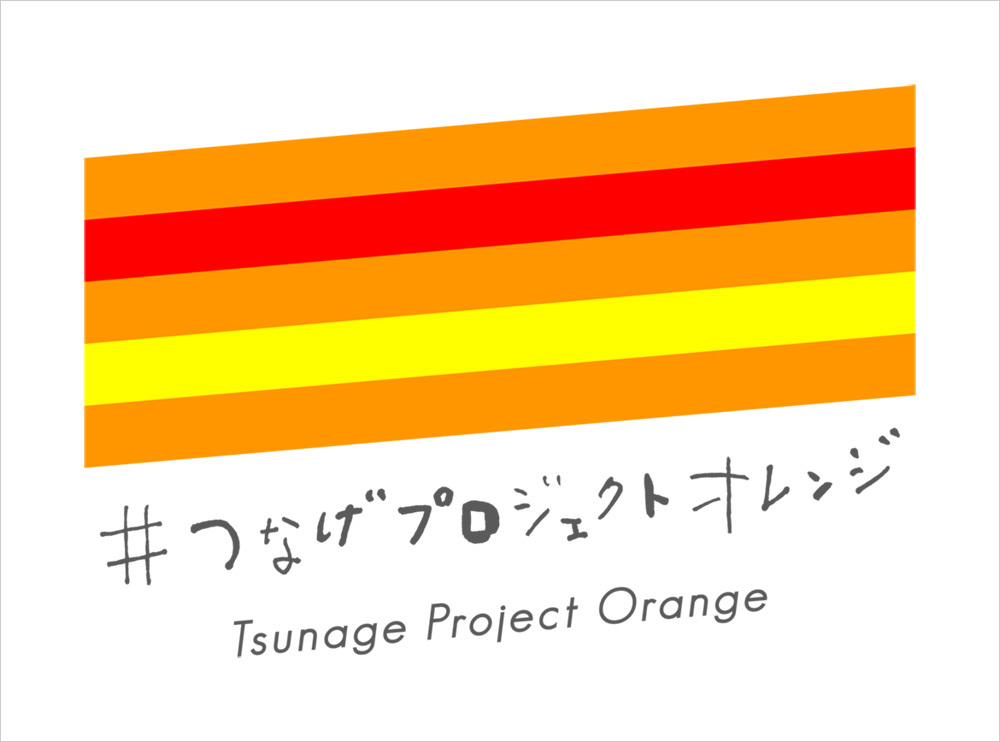
The wave of aging reaches here too. The urgent challenge is the shortage of "young donor registrants."
Celebrating its 32nd year in 2023, the Japan Marrow Donor Program (JMDP) is a public interest incorporated foundation that operates a public service connecting patients needing hematopoietic stem cell transplants—such as bone marrow transplants for leukemia and other blood disorders—with donors who provide them. It broadly recruits hematopoietic stem cell donors to save patients and acts as a bridge between them.
However, it currently faces a shortage of donors from the younger generation. While the latest data shows 547,708 registered donors—a number that is by no means small—and 1,622 registered patients, looking at the numbers alone might suggest there is no shortage. However, the crucial factor is matching the white blood cell type. The probability of a match is one in four for siblings, but drops dramatically to one in tens of thousands for unrelated individuals. This means the donor pool still needs to grow significantly. Yet, preceding this urgent need is the pressing issue of the current registered donors' aging.
The upper age limit for donor registration with the bone marrow bank is 54; at age 55, donors graduate from the registry. In contrast, donors aged 40 and above currently make up 60% of the registered donor pool (as of the end of December 2022). This means that over the next decade, 220,000 people will turn 55 and graduate from being donors, creating a critical situation. While it would be ideal if registrations from younger generations were increasing, surveys* show that awareness of the bone marrow bank's activities is still low: only 14.2% of those aged 18-29 and 23.3% of those aged 30-39 reported knowing about it, both figures below the overall average of 25.1% (※).
※ "Public Opinion Survey on Transplant Medicine (August 2017 Survey)" (Cabinet Office)
https://survey.gov-online.go.jp/h29/h29-ishoku/zh/z11.html
Furthermore, even when selected as a compatible donor, many cases do not proceed to donation due to reasons other than health concerns. Among those who declined donation after receiving a match notification, the top reasons cited in the graph below for declines unrelated to health were "Unable to arrange it (40%)" and "Could not be contacted (32%)". Pre-transplant screening is required, and collecting bone marrow fluid necessitates a 3-4 night hospital stay, followed by post-discharge follow-up visits. Even with the willingness to donate, few employers or schools currently offer support systems. Consequently, many donors reluctantly give up their transplant opportunity. While increasing donor registrations is crucial, establishing social systems to support donors during the actual donation process is equally vital.
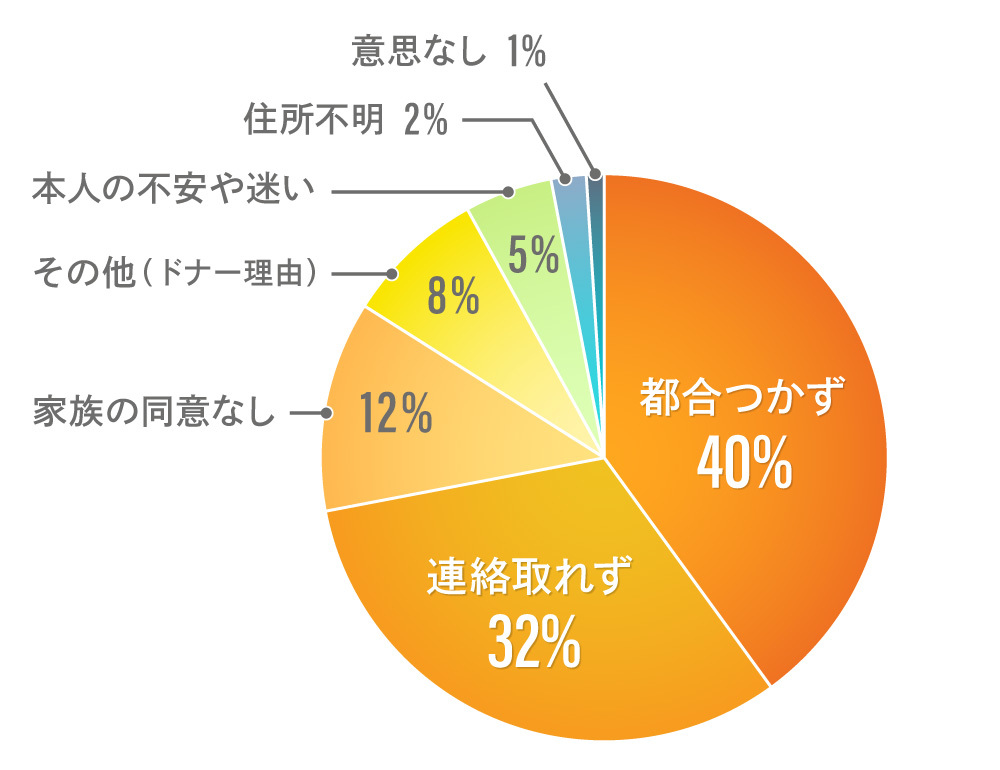
The kickoff event for the recently launched "#Connect Project Orange" also showcased awareness posters created in the past. As an aside, a poster from 2001 featuring the late actress Masako Natsume, who passed away from leukemia, stated that 1,600 patients were waiting for transplants. This number is remarkably similar to the current waiting list mentioned earlier. It starkly reminded us of the immense challenge in achieving the goal of zero patients waiting, highlighting how little progress has been made.
Beyond increasing donor registrations, establishing a supportive environment for donors is an urgent priority.
Establishing social support systems requires organizations like companies and universities to change their existing rules, presenting a high hurdle. To achieve this, leadership from individuals with conviction is essential; for example, corporate executives or university presidents need to take the initiative and speak out. However, even if these initial efforts require some effort, the positive societal recognition that follows makes it well worth the investment. Relevant government agencies, which should be central to driving these activities, would likely welcome and express gratitude for such actions. Companies are now being called upon to fulfill new roles within the community as responsible citizens.
Indeed, the call for companies to actively participate in such social activities is growing. The public's sympathy for activities that benefit society, often termed "social good," is particularly strong among younger generations. This presents a valuable opportunity for companies seeking to connect with younger demographics, including for recruitment purposes.
The Japan Marrow Donor Program (JMDP), which has traditionally focused on raising awareness about donor registration, is now also strengthening supporting conditions. This includes promoting "donor leave systems" within companies, local governments, and universities, as well as implementing "donor support systems" that provide financial assistance. The newly launched "#Connect Project Orange" represents the Japan Marrow Donor Program's renewed determination and declaration to visualize this diverse support from companies and individuals as one major movement, using WMDD as a catalyst.
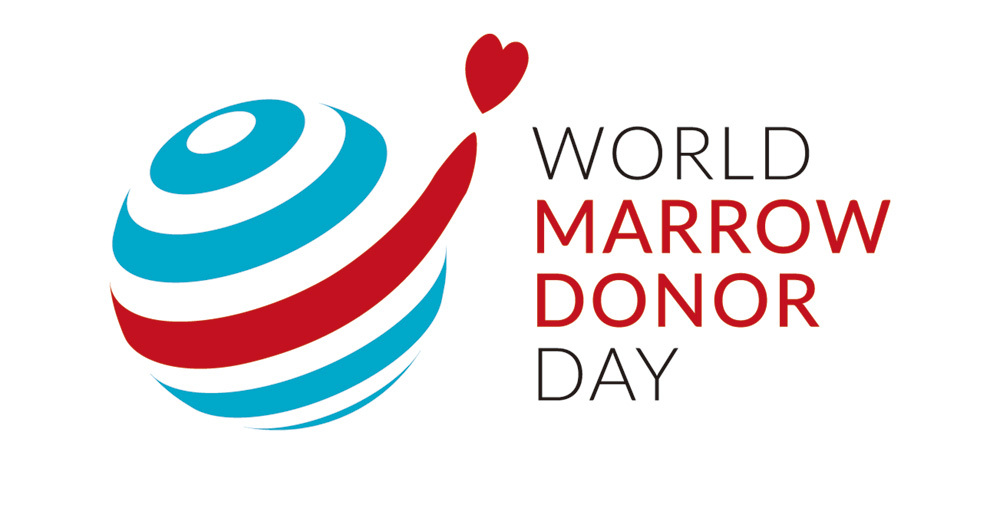
Global Pioneering Campaigns: Co-creation and Emergence by Groups and Individuals
In fact, quite large-scale campaigns are already being conducted overseas for WMDD. Examples range widely, such as illuminating Niagara Falls in orange on the third Saturday of September, designated as WMDD, to raise awareness, and producing and releasing a virtual comic book by cartoonist Angus Cameron that portrays donors as dedicated young heroes. Incidentally, this virtual comic was also utilized at a Florida pop culture convention to encourage donor registration. Additionally, the social media campaign featured creative content posted by actual donors and college students who registered, achieving over 100,000 impressions and a potential reach of 168,000. This proved effective in connecting with younger generations. Recognized for its success, the campaign won the Grand Prix at The Loeries Awards, which honors outstanding communication examples in the South African region.
Through social media, activities happening worldwide are widely shared, and the passion of each initiative seems to fuel the motivation of teams in other regions. People of conscience around the globe, united by the same purpose, make full use of the 24 hours of WMDD. This momentum circles the globe as time passes. Unlike before, the WMDD headquarters now encourages each area to adopt unique approaches rather than standardizing activities. Here, too, participants' creativity shines as they consider how their audience will interpret the message and translate it into action. This hackathon-like process, where new initiatives transcend past conventions and gain supporters including younger generations, embodies the contemporary spirit of the WMDD project.
In Japan, this kickoff will also launch a social media campaign to connect with younger audiences (https://twitter.com/JMDP1789). Companies already aware of the initiative and exploring ways to support it have reportedly inquired about developing merchandise using these visuals. For those who share the vision, taking proactive, concrete steps could serve as an excellent messaging opportunity to position themselves as leaders in this movement.
Corporate Initiatives and Media Stances on Social Issues
At the kickoff event, speakers from companies and media outlets also shared their perspectives. In the session titled "Corporate Activities That Connect with Society? ~Work Philosophy in an Era Connected by 'Meaning'~," Kazuo Chiku of Tully's Coffee Japan and Kota Kawami of Beacon Communications K.K. discussed their current initiatives.

Tully's Coffee, a coffee shop chain, has a distinctive store opening strategy. Starting with a location at the Japanese Red Cross Medical Center in Hiroo, they have actively opened stores within hospitals since 2004. This stems from a desire to provide patients within hospitals with a relaxing space reminiscent of being in the city. Since 2020, Tully's has distributed bone marrow bank pamphlets in its stores, and this relationship continues today. Kawami noted that such initiatives often originate from individual appeals, and it is the strength of that conviction that ultimately moves the company and solidifies its stance.
Mr. Kawami of Beacon Communications K.K., who created copy for the "#Connect Project Orange," stated that a company's approach to social issues influences consumer choices and impacts recruitment. He emphasized that companies cannot be accepted by people solely by making money. In this sense, he urged companies to pay attention to social initiatives like "#Connect Project Orange" and actively seek meaning in their involvement. He added that it would be ideal if cafes like Tully's could lead such awareness campaigns, stressing the importance of creating opportunities for each company to leverage its expertise and build a network engaged in these efforts. Incidentally, this kind of teaming—where organizations from different sectors collaborate—closely resembles the "Collective Impact" model, a concept of diverse organizational commitment that is more advanced in Europe and the US. (For more on Collective Impact, please refer to our separate article: https://dentsu-ho.com/articles/8624 )
Additionally, addressing the question of what stance media should take toward these activities, a panel titled "From Media That Reports to Media That Connects: Individual Voices and the Role of Media in the SNS Era" was held. Moderated by former NHK journalist Daisaku Kawase, the panel featured Shinsaku Toyoshima, WBS Anchor and Deputy Digital Editor-in-Chief at TV Tokyo News Bureau, and Azusa Mizuno, Editor-in-Chief of Asahi Shimbun's withnews.
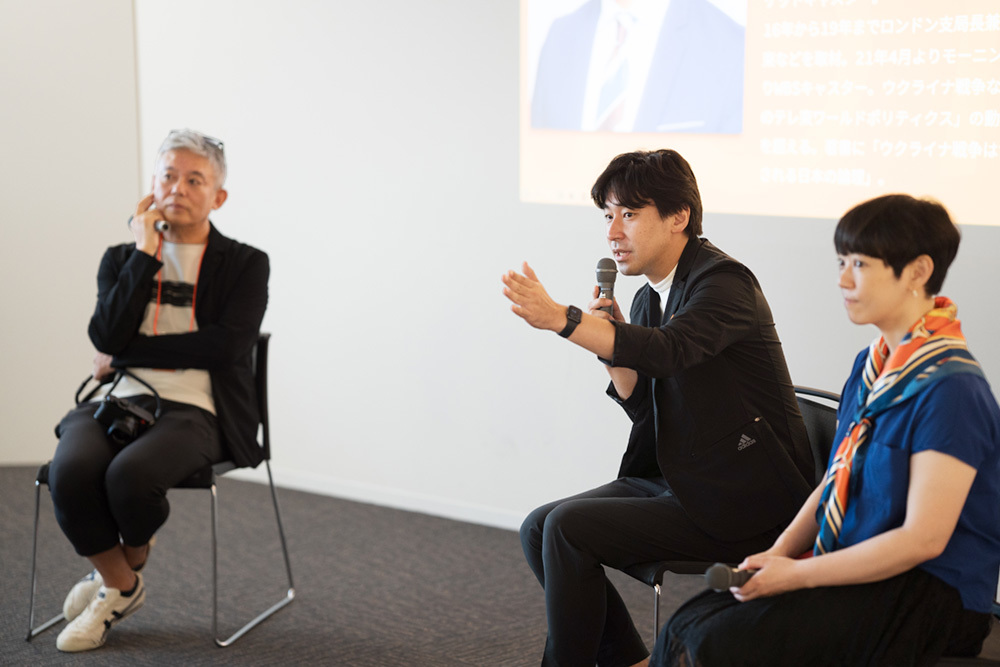
The discussion centered on how much personal opinion media can express while adhering to the overarching principle that it must always report objectively. Mr. Toyoshima, who himself donated bone marrow and actively proposed covering that process in the news—a proposal that was adopted—spoke of the difficulty of this position. Nevertheless, he affirmed that television's responsibility is to continue delivering essential information to the public.
Addressing the same issue, Mizuno stated that while media organizations have their institutional stance, she aims to communicate in a way that makes people think, "This person is saying this, so I should listen," recognizing her role as an individual human being. Moderator Kawase concluded, "The role of media is changing daily. Going forward, it's crucial to act not just as conveyors of information, but also with an awareness of our role as connectors."
While media objectivity is indeed a necessary fortress to defend, the individuals conveying the information are ordinary people. This forum became a valuable space where that internal conflict was shared, and where the struggles of those in such positions could be understood. That said, moving forward, might the field of media itself evolve into an environment where individuals can express their personal opinions while still standing within that field? In Western media, figures known as news anchors typically make their own opinions clear as a matter of course. I feel such statements are increasing even in Japanese news. While caution is sometimes warranted when voicing personal opinions, who could possibly deny the stance of encouraging it in response to campaigns like this one? Furthermore, even if multiple groups exist pursuing similar goals, if they stand together facing the same challenge, I believe it's not just me who thinks they could set aside minor differences in principles and assertions, collaborate, and push forward decisively toward solving the issue.
Support voices continue pouring in from the sports world: Providing "Peace Donor Seats" for game attendance
On September 16th, the same day as the kickoff event, "Peace Donor Seats" were set up at MAZDA Zoom-Zoom Stadium Hiroshima in Hiroshima Prefecture for the Hiroshima Toyo Carp vs. Hanshin Tigers game to raise awareness about the bone marrow bank. Twenty people aged 25 and under were invited. Before the game, a separate booth explained the current status and challenges of the bone marrow bank, with former patients also participating to encourage donor registration. This initiative also connects to the story of Hiroshima Carp alumnus Manabu Kitabeppu, who was diagnosed with adult T-cell leukemia and passed away this past June after battling the disease through a bone marrow transplant. The idea originated from last year's "Ideas Festival to Change Society: Imagination Saves Lives," organized by the Japan Marrow Donor Program with the participation and cooperation of high school and university students. ( https://www.youtube.com/watch?v=mEFJjuUBii4 )

The first adoption of this "Peace Donor Seat" occurred during the men's final match of the V-League Final Stage in April 2023. At the venue, Yoyogi National Gymnasium, the seats were installed, and educational sessions, fundraising activities, and other awareness efforts were conducted.

Then, fulfilling the wish of the students from Kurose High School in Higashihiroshima City who proposed the idea, it was finally realized at a game of their local team, the Hiroshima Carp. The 20 participants that day cheered repeatedly, holding up orange-colored towels in reference to the "#Connect Project Orange."
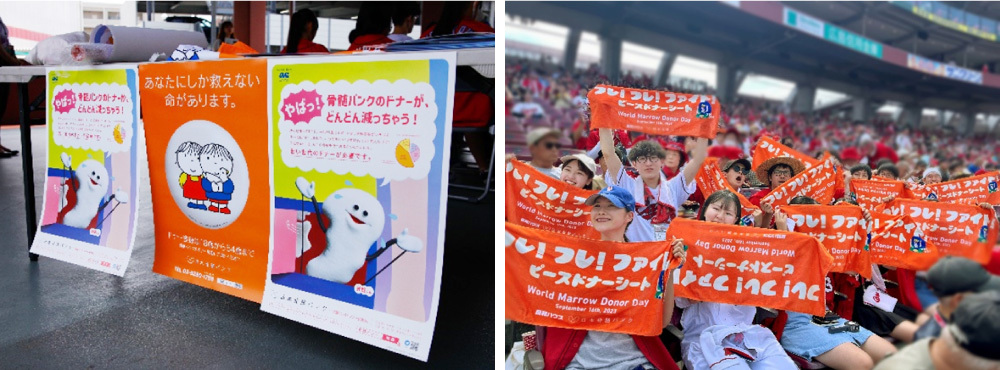
Support from the sports world is also growing. In rugby, Tokyo Suntory Sungoliath player Takahiro Kimura wore an orange wristband during a match. Kimura decided to take this action after meeting 5-year-old rugby fan Kenchiku Tanaka, who suffers from the rare blood disorder "Idiopathic Aplastic Anemia," through an acquaintance. He also participated in the kickoff event for the #ConnectProjectOrange, reiterating the importance of raising awareness.
Keita Suzuki, Chief of the Japan Marrow Donor Program's Public Relations Team, stated: "We believe sports hold tremendous power as a point of connection with young people. If the support of fans for patients who can no longer play sports due to illness unites, we can change society. We hope to build on these examples of support and expand collaboration with companies and organizations interested in similar initiatives."
Moving forward, the #ConnectProjectOrange aims to expand broadly by recruiting partners for these concrete activities alongside its social media campaign. We will be watching closely to see which companies participate.
Was this article helpful?
Newsletter registration is here
We select and publish important news every day
For inquiries about this article
Author

Iguchi Osamu
PR Consulting Dentsu Inc.
Executive Officer
Chief PR Planner
We handle a wide range of services, from developing data-driven corporate PR strategies to strategic PR for products and services, viral campaigns utilizing video content, and municipal PR. Proposes initiatives like "PR IMPAKT," which creates content likely to trend in news and social media, and "Information Flow Structure," which unravels information pathways across media. Over 30 years of experience in PR agencies. Recipient of numerous awards including "World's Top 50 PR Projects," "Cannes Lions Grand Prix," "Asia Pacific Innovator 25," and "Gunn Report Top Campaigns 100." Has served as a judge for numerous domestic and international awards, including Cannes Lions, Spikes Asia, SABRE Awards Asia-Pacific, PR Awards Asia, Japan PR Association PR Award Grand Prix, and Nikkei SDGs Idea Competition. Author of "The Essence of Strategic PR: Five Perspectives for Practice" and co-author of "Learning from 17 Successful Cases: Local Government PR Strategy."


